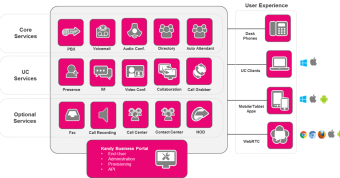Ubiquity & Technology
Part two of a four part series:
Part one: Communications Without Boundaries
Part three: Embedded Communications
Part four: Digitization to Humanization
When aren’t we connected? Given advancements in software that allows our interactions to move with us, passing invisibly from one network to another, we can literally now carry on digital discovery, conversations and collaboration wherever we can catch a signal. Mobile phones are now personal hot spots. What used to cost $500- $1,000 a year for a personal hot spot connection with a USB antenna (which itself cost $200- $300) is now available as a hot spot service on a smart phone for a few extra dollars a month, as a hot spot “app” and add-on subscription. Cars are mobile hot spots.
Our devices are our tether to the always-on, always moving digital communications ecosystem. Connecting us to our friends and family, our co-workers, our social networks, our news and information sources, and more and more – our sports, entertainment and music. We got hooked on ubiquitous computing with the cloud – and it made our days more productive and our lives easier and more enjoyable.

Now, we are seeing a second surge of growth, with ubiquitous communications. This is increasing the number of possibilities we have all day and all night long – and an ever increasing volume in the number of seconds we access, the number of applications and connections we have at our fingertips. All of this is convenient, right?
But at what point will we need to figure out an even more efficient way to keep ourselves connected, productive, entertained, healthy, safe, and generally aware? How much can one human being process in one day?
There is quickly coming a time where we ache for simplicity again. We long for the relative ease of being able to simply talk ideas through (without having to dial a phone number or reply to a tweet). We want to whiteboard concepts when the inspiration hits (without having to set up and join a conference bridge or screen sharing service). Companies need experts to help a colleague in the field through a service call (simply by connecting on browsers). Humans expect to converse with our voice and eyes again (without resorting to typing!)
Innovations in presence and location have made it easier for us to control our own “communications policy,” deciding to whom we are available at all times (our spouses, partners, children, parents), which individuals we are happy to connect with when at work (our bosses, colleagues, business partners) and those we are not open to at all. We are now including brands, advertisers, and mere acquaintances in these different lists.
 Ultimately, time is all we have. We can only spend that time via energy and attention. To remain sane – and happy – it is becoming incumbent upon every individual to learn how to manage their own “real-time communications”. We all have to find the tradeoffs we are willing to make in our lives.
Ultimately, time is all we have. We can only spend that time via energy and attention. To remain sane – and happy – it is becoming incumbent upon every individual to learn how to manage their own “real-time communications”. We all have to find the tradeoffs we are willing to make in our lives.
While much has been written about the skyrocketing growth of Machine-to-Machine communications, the vast majority – today – occurs invisibly in the background. For example, a sensor on an oil rig in the middle of the Indian Ocean may alert a system that the temperature and humidity are approaching dangerous levels, so a highly sophisticated energy management software system starts to increase air conditioning to ensure operations while also managing expense.
On the consumer front, more and more software platforms are emerging making it possible for consumers to manage their energy bills with applications that are reading their thermostat and energy consumption. Energy companies are offering real-time contact center support to create a win/win with consumers and their own bottom lines (not to mention big data which can continually be analyzed towards a more stable and affordable energy resource).
Let’s take it a step further, and envision a day when the smart thermostat in your home, connected to your smart security system, and tethered to you by your mobile device, calls and says in a beautiful nearly-human voice, “It’s 9 PM, you’re not home yet, should we wait to initiate cooling?” You respond, “Yes, I should be arriving at 10.” The artificially intelligent agent responds “I understand, have a safe trip home.”
 This is not futurism, nor is it science fiction. This is all quite possible today. And as we develop relationships with other humans and human-like voices, our experience of being altogether human continues to morph. Our communications are becoming embedded in everything we do. One could argue that as humans become more like machines by texting, our machines are taking on more human characteristics like the ability to understand human speech and respond directly. The lines blur.
This is not futurism, nor is it science fiction. This is all quite possible today. And as we develop relationships with other humans and human-like voices, our experience of being altogether human continues to morph. Our communications are becoming embedded in everything we do. One could argue that as humans become more like machines by texting, our machines are taking on more human characteristics like the ability to understand human speech and respond directly. The lines blur.
THE VALUE OF CONNECTIONS AND COMMUNICATIONS
Nothing new can be built, no business can be run, no one can be educated, no one can be cared for today and in the future without connectivity and collaboration within human groups. Of course, life can go on in remote places, with absolutely no technology, but those places are increasingly becoming the exception. So how does one place a value on the continual, rich, immersive and increasingly high definition digital interactions going forward?
It is no secret that competition for users or subscribers, especially in regions where population is dense, is fierce. This is driving down pricing (and by extension increasing perceived value) of digital communications. Providers have been forced to offer “all the data you can eat” plans and more relaxed rollover policies. The massive communications service providers have to reach for volume, even if at the expense of margin, in order to “monetize” their extreme capital investments in deploying infrastructure. Billions upon billions of dollars are going into the ground, under the oceans, into skyscraper “risers,” into data centers, into towers, and into software to manage it all.
Billions are going into developing the next mobility devices. Billions are going into large and small format screens, which are completely transforming classrooms, hospital rooms, stadiums, transportation hubs, offices and homes, satisfying our hunger for “the screen life.”
Over the last few decades, much of the value for innovation in real-time communications software, like cloud computing, has been based on cost savings. Expensive to buy, in some cases, but less expensive to run, manage, fix and innovate. “Productivity” has been a major theme for cloud, particularly in the CRM and ERP mass deployments.
Today, the value of “Unified Communications” in the cloud (UCaaS) is being predicated upon these same productivity gains, while also adjusting to the “consumerization of IT”. Yet many enterprises are moving cautiously. They are stuck between dated telephone systems, IP-PBX investments and business processes that rely on “desk phones” and the outcry from employees, especially Millennials, who do everything else on their mobile devices except work.
The question of value seems a little stuck between a rock and a hard place (reducing or at least controlling expenses, and delivering greater productivity and employee satisfaction) which only further begs a simple answer to the question – what is all this worth?
Steve Jobs once wrote, “My favorite things in life don't cost any money. It's really clear that the most precious resource we all have is time.” So are more natural, intuitive and therefore efficient communications with other human beings something almost invaluable?
Value and price are often out of balance, but one massive sea change we are just starting to experience is the value/price relationship of cloud communications following in the footsteps of cloud computing. By the drop – not by the day. By the second – not by the subscription. With more and more real-time communications functions being driven by software defined networks and within fully elastic virtualized environments, “shared resources” takes on a whole new meaning; with advancements in session management, including separation of signaling and media, making load balancing and resource management even more precise – the economics associated with delivering services is changing completely.
No longer are we as bound to platforms as we are boundless and without boundaries when we leverage platforms – as a service. We predict that cost – pricing – margins – value – and value creation will be the real innovation for the real-time communications industry moving forward.
In part three of this four part series I will explore the possibilities of embedded communications by offering some great examples of how this technology can be used.




